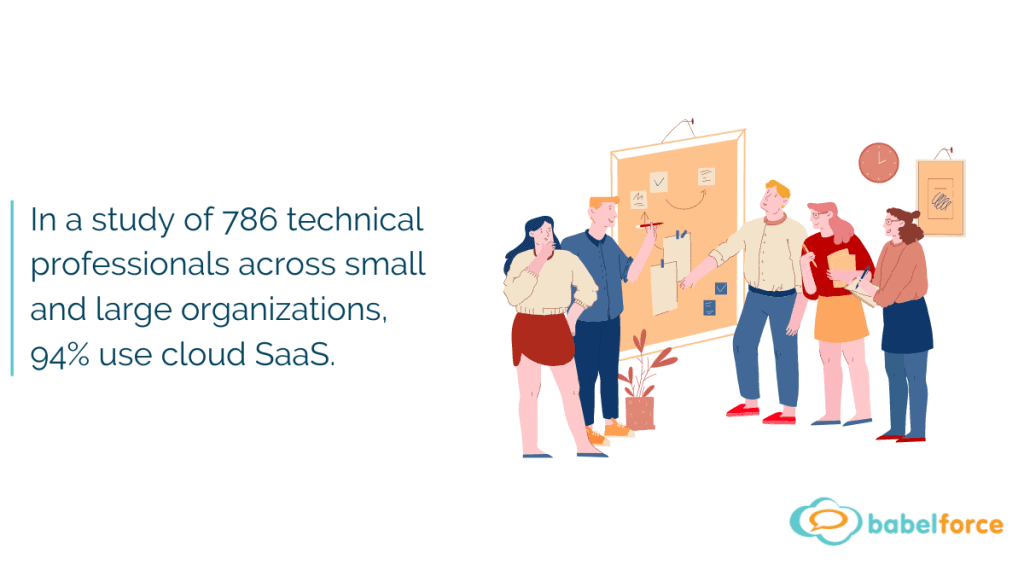In this post:
- What is SaaS?
- What sets SaaS apart?
- How does SaaS add value to CX?
- CX strategies that SaaS makes possible
What is SaaS?
SaaS stands for Software as a Service. It’s a cloud-based service that enables users to access internet applications via a web browser.
It is one of three categories of cloud computing:
1. Infrastructure as a service (IaaS)
2. Platform as a service (PaaS)
3. Software as a service (SaaS)
SaaS is the most commonly used model. Just take a look at your computer screen. Email applications, desktop tools, and streaming services all function through SaaS cloud services.
Why? Predominantly because of its usability. Few (or even zero) developers or computer engineers are required to manage, install and update the software. With SaaS, a far wider pool of non-technical staff can run the show in just a few clicks of a mouse.
In remote locations, users can achieve all this with only a network connection and a web browser. Such accessibility is a far cry from the local computer and server dependency of PaaS and IaaS models.
However, this is just one of many reasons why more companies are choosing SaaS tools to support their customer experience transformation projects.

What sets SaaS apart?
With SaaS, a company simply sets up a server in the cloud. The software is ready for use in just a couple of hours.
In a world where most companies fail to keep up with customer expectations, such speed is essential. Yet, there are many more benefits that set the SaaS model apart.
Consider the table below. A SaaS vendor will provide and maintain every element put forward. Providers of IaaS and PaaS software will not offer the same level of remote support.
| IaaS | PaaS | SaaS | |
| Hardware | ✓ | ✓ | ✓ |
| Virtualisation | ✓ | ✓ | ✓ |
| OS | x | ✓ | ✓ |
| Runtime | x | ✓ | ✓ |
| Data | x | x | ✓ |
| Application | x | x | ✓ |
Sticking with the remote theme, multiple users may access SaaS software regardless of their location. They can also store and save data.
Yet, in terms of adding the most value to an organization, we’ve filtered the many benefits down into four major areas that set SaaS apart. These are:
- Cost reduction – IT overhead costs are a problem of the past, as SaaS providers manage applications on each company’s behalf. Most will also charge through a subscription-based model, which – typically – includes support costs. As such, businesses can wave goodbye to on-premise license fees and hefty upfront payments.
- Accessibility – When COVID-19 struck, it became mission-critical for companies to switch to SaaS and enable remote access to all business systems. With only a stable internet connection required, businesses found that geography was no longer a significant issue. Of course, sometimes, compliance regulations – such as GDPR – require all data to be housed in one central location. Nevertheless, SaaS is a highly secure solution.
- Scalability – As a company grows or shrinks, the SaaS solution scales accordingly. If a company wishes to add more databases or computing power, the SaaS provider takes care of that on an as-needed basis. Business transformation then becomes rapid.
- Easy updates – With SaaS, there is no need for manual, time-consuming updates. Everybody is always working from the latest version of the software. Frictions created by compatibility issues will no longer frustrate users.

How SaaS adds value to CX
Offering insight into the current state of CX, Forrester research suggests that: “Customers are connecting with brands through digital touchpoints in new ways and at a higher volume.”
The scalability that SaaS platforms offer enables contact centers to better deal with these rising volumes. However, in terms of providing an effortless experience across digital touchpoints, the cloud service has much more to offer.
Simple API integrations allow systems to work together in harmony while speeding up new technology additions. Such additions will likely include digital automation tools, which help companies meet rising customer expectations, as highlighted by Forrester.
Easy-to-use digital automation tools are No-Code, offering self-service, digital deflection, and proactive messaging capabilities. These enable CX teams to act quickly, provide new services and keep up with current customer needs.
Also, within a SaaS environment, streams of data will flow between different systems. As this is the case, information becomes more readily available, and teams can build more sophisticated CX strategies.

CX strategies that SaaS make possible
Consider a SaaS architecture that includes a digital automation tool and a CRM system. With an API integration, businesses can make use of omnichannel messaging to retain customers.
We call this “customer retention outreach”.
Using data within the CRM, companies can highlight service renewal dates and pass these through to the digital automation tool. With this information, businesses may send automated reminders to customers who are yet to renew.
Such a tactic increases retention rates. However, a CX infrastructure built on SaaS integrations enables many more digital CX improvement strategies. For example:
· Call-backs to save customers from long call queues.
· Digitized onboarding to automate customer enrolment.
· Personalized self-service to simplify digital journeys.
Each of these examples improves CX by bolstering the contact center’s capabilities alone. However, with SaaS, companies can break down business silos across the organization to further benefit CX.
Again, this bolsters the contact center. Agents can uncover answers to customer queries hidden within the back office, billing, or the supply chain.
However, other departments – such as marketing, design, and finance – also benefit from a fully integrated SaaS solution. They can access CRM data and contact center reports to extract valuable customer insights.
With SaaS reporting tools, companies may go further and create a unified view of CX. Having this shared platform of insights encourages collaboration, which is the cornerstone of CX improvement.

Go crazy for SaaS too!
Eager to migrate your CX systems to a SaaS model? babelforce is here to help.
From moving entire contact center ecosystems into the cloud to providing specialist API integrations, our experienced team will set your business up for SaaS success.
To learn more about how our SaaS software improves CX, visit our product page.Also, stay up to date with all of our latest blog posts, eBooks, and announcements by following us on LinkedIn and Twitter.





